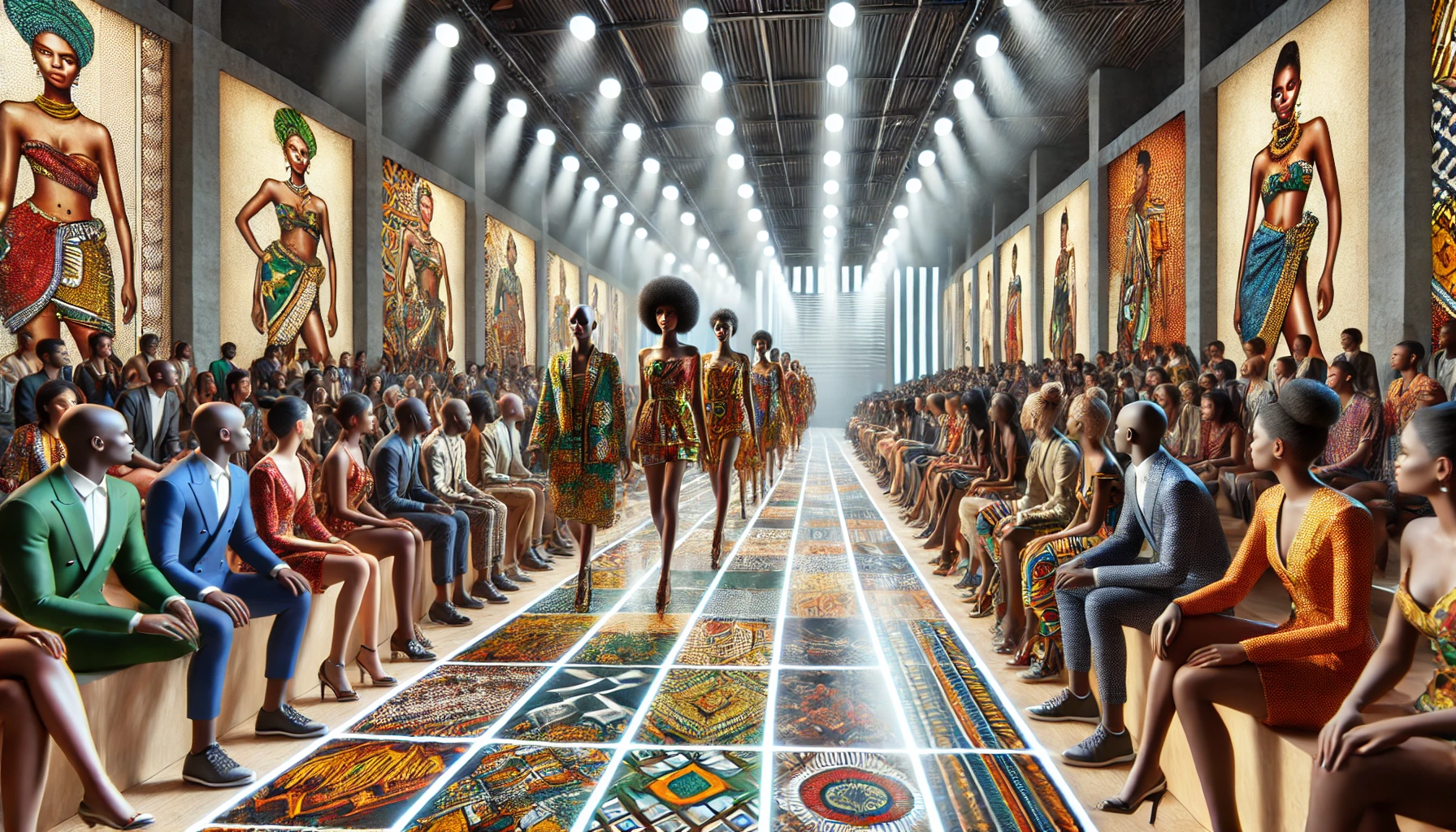Introduction
African prints have a rich history and cultural significance that span centuries. These vibrant and intricate designs are not just patterns but a visual representation of heritage, stories, and traditions.In recent years, African print has made a significant impact on the world of fashion, blending traditional aesthetics with modern style in a seamless way. This fusion has led to a fashion movement that celebrates diversity, culture, and creativity, and it is gaining popularity among fashion enthusiasts. In this article, we will take a look at some of the most popular African print trends in modern fashion, exploring their origins, meanings, and how they are incorporated into today's fashion industry.

The Timeless Appeal of Ankara Prints
Origins and Cultural Significance
Ankara prints, also known as African wax prints, are one of the most iconic and widely recognized African prints. Originating from Nigeria, these prints are characterized by their bold colors and striking geometric patterns. The technique used to create Ankara prints involves wax-resist dyeing, a method that gives each fabric its unique, vibrant look. This process, which dates back to the 19th century, was initially inspired by Indonesian batik brought to West Africa by Dutch traders.
Ankara prints hold significant cultural significance. They are often worn during traditional ceremonies, festivals, and celebrations, symbolizing unity and identity. The designs and patterns on the prints can also convey various meanings and messages, often related to proverbs, historical events, or social status.
Modern Fashion Integration
In contemporary fashion, Ankara prints have transcended their traditional roots to become a global phenomenon. Designers around the world have embraced Ankara for its versatility and bold aesthetic. It is now commonly used in a wide range of clothing items, including dresses, skirts, jackets, and accessories such as bags and shoes. Modern interpretations of Ankara often involve combining it with other fabrics or using it in unexpected ways, such as in swimwear or streetwear.
Celebrities and fashion influencers have played a significant role in popularizing Ankara prints. High-profile figures like Beyoncé, Rihanna, and Lupita Nyong’o have been spotted wearing Ankara-inspired outfits, bringing this traditional fabric to the global fashion stage. This visibility has helped to integrate Ankara prints into mainstream fashion, making them a staple in many wardrobes.
The Symbolism of Adinkra Prints
Origins and Cultural Significance
Adinkra prints originate from the Ashanti people of Ghana and the Gyaman people of Côte d'Ivoire. These prints are unique because they are imbued with symbolic meanings. Each Adinkra symbol, known as an "Adinkrahene," represents concepts or aphorisms. For example, the "Gye Nyame" symbol signifies the supremacy of God, while "Sankofa" means returning to one’s roots or learning from the past.
Traditionally, Adinkra cloths were worn during sacred and ceremonial occasions, especially funerals. The process of creating Adinkra involves stamping or screen-printing symbols onto cloth, which is typically dyed in deep, rich colors.
Modern Fashion Integration
Adinkra prints have found their way into modern fashion, where their symbolic meanings add depth and cultural significance to contemporary designs. Designers use these prints to create clothing that not only looks beautiful but also tells a story or conveys a message. Adinkra symbols have been incorporated into everything from casual wear to high fashion, including dresses, shirts, scarves, and even accessories like jewelry and handbags.
The resurgence of interest in African heritage and culture has made Adinkra prints particularly popular among young fashion enthusiasts who seek to connect with their roots or appreciate the rich cultural history they represent. Fashion brands like Studio 189 and Osei-Duro have been at the forefront of integrating Adinkra symbols into modern, stylish pieces that appeal to a global audience.
The Vibrancy of Kente Prints
Origins and Cultural Significance
Kente prints are perhaps one of the most recognizable African textiles, originating from the Ashanti Kingdom in Ghana. Known for their bright colors and intricate patterns, Kente cloths are traditionally woven on looms in narrow strips that are then sewn together to form a larger piece of fabric. Each color and pattern in Kente carries specific meanings, often reflecting the history, philosophy, and social values of the Ashanti people.
Kente cloths were historically reserved for royalty and special occasions, symbolizing wealth, high social status, and cultural heritage. The complexity of the weaving process and the significance of the designs make Kente a cherished and revered textile.
Modern Fashion Integration
Today, Kente prints have become a popular element in modern fashion, celebrated for their vibrant hues and geometric designs. Fashion designers incorporate Kente patterns into various garments, including tailored suits, evening gowns, casual wear, and even sportswear. The adaptability of Kente prints allows them to be used in both traditional and contemporary styles, making them a versatile addition to any wardrobe.
In the fashion industry, Kente has also become a symbol of African pride and heritage. Designers such as Ozwald Boateng and Virgil Abloh have featured Kente-inspired pieces in their collections, showcasing the print’s versatility and cultural significance. This global exposure has helped to elevate Kente from a traditional African textile to a beloved and fashionable fabric worldwide.
The Elegance of Batik Prints
Origins and Cultural Significance
Batik prints are another stunning example of traditional African textiles that have found a prominent place in modern fashion. The batik technique involves applying wax to fabric in specific patterns and then dyeing the fabric. The wax resists the dye, creating intricate designs once the wax is removed. While batik is often associated with Indonesian culture, it has also been embraced and adapted in various African countries, particularly in West Africa.
In Africa, batik prints are known for their intricate and symbolic designs, often representing local flora, fauna, and cultural motifs. The method of creating batik is labor-intensive, highlighting the craftsmanship and artistry involved. These prints are commonly used in traditional attire and for special occasions, symbolizing beauty, tradition, and cultural pride.
Modern Fashion Integration
Modern fashion has embraced batik prints for their unique and sophisticated patterns. Designers incorporate batik into a wide array of garments, from casual summer dresses to elegant evening wear. The versatility of batik allows it to be used in both formal and informal settings, making it a favorite among fashion enthusiasts looking for distinctive and artistic prints.
Fashion brands like Lemlem and Loza Maléombho have been instrumental in bringing batik prints to a global audience, blending traditional techniques with contemporary designs. These prints are often featured in fashion collections that celebrate African heritage while appealing to modern tastes.
The Richness of Yoruba Prints
Origins and Cultural Significance
Yoruba prints, originating from the Yoruba people of Nigeria, are renowned for their vibrant colors and intricate patterns. One of the most well-known Yoruba fabrics is Adire, which means "tie and dye" in the Yoruba language. Adire is created using various resist-dyeing techniques, resulting in beautiful, abstract patterns on the fabric.
Yoruba prints are deeply embedded in the cultural and social life of the Yoruba people. They are often worn during significant events such as weddings, festivals, and religious ceremonies, symbolizing identity, heritage, and social status. The patterns and motifs used in Yoruba prints often carry specific meanings and stories, reflecting the rich cultural tapestry of the Yoruba people.
Modern Fashion Integration
In contemporary fashion, Yoruba prints, particularly Adire, have gained popularity for their unique and expressive designs. These prints are now used in a variety of clothing items, including shirts, skirts, trousers, and accessories. The resurgence of interest in traditional African textiles has led to a renewed appreciation for the artistry and cultural significance of Yoruba prints.
Designers like Maki Oh and Kenneth Ize have been at the forefront of integrating Yoruba prints into their collections, showcasing the versatility and timeless appeal of these fabrics. By blending traditional techniques with modern silhouettes, these designers are helping to preserve and promote Yoruba heritage while appealing to a global audience.
The Vibrant Beauty of African Wax Prints
Origins and Cultural Significance
African wax prints, also known as Dutch wax prints, are perhaps the most widely recognized type of African textile. These prints are created using a wax-resist dyeing technique, similar to batik, but with a distinctively African flair. The origins of wax prints can be traced back to the 19th century when Dutch traders introduced Indonesian batik to West Africa. Over time, these prints evolved into a unique art form, reflecting African aesthetics and cultural themes.
Wax prints are characterized by their bold colors, geometric patterns, and striking designs. Each print often tells a story or conveys a message, with motifs that represent various aspects of African life, from proverbs and folklore to historical events and social commentary.
Modern Fashion Integration
The vibrant beauty of African wax prints has made them a staple in modern fashion. These prints are used in a wide range of clothing and accessories, from traditional African attire to contemporary streetwear. The versatility of wax prints allows them to be incorporated into various fashion styles, making them a favorite among designers and fashion lovers alike.
Brands like Vlisco and Woodin have played significant roles in popularizing wax prints, offering a wide array of designs that cater to different tastes and preferences. These prints are often featured in fashion shows and collections around the world, highlighting their global appeal.
Celebrities and influencers have also embraced African wax prints, wearing them on red carpets, in music videos, and in everyday life. This visibility has helped to elevate the status of wax prints, making them a sought-after fashion statement that celebrates African culture and creativity.
The Cultural Richness of Fulani Prints
Origins and Cultural Significance
Fulani prints originate from the Fulani people, who are one of the largest ethnic groups spread across West Africa. Known for their vibrant colors and intricate patterns, Fulani prints often incorporate geometric shapes and symbolic motifs that reflect the rich cultural heritage of the Fulani people.
Traditionally, Fulani prints are used in clothing and textiles that are worn during important cultural and social events. These prints not only serve as a form of artistic expression but also convey social status and cultural identity.
Modern Fashion Integration
In modern fashion, Fulani prints have gained popularity for their bold and distinctive designs. Designers use these prints to create clothing and accessories that celebrate African heritage while appealing to contemporary tastes. Fulani prints are often featured in fashion collections that emphasize cultural diversity and artistic excellence.
Fashion houses like Christie Brown and Andrea Iyamah have incorporated Fulani prints into their designs, showcasing the versatility and beauty of these traditional textiles. By blending traditional patterns with modern fashion elements, these designers are helping to preserve and promote the cultural richness of Fulani prints.
The Distinctive Charm of Dagomba Prints
Origins and Cultural Significance
Dagomba prints hail from the Dagomba people of Northern Ghana. These prints are renowned for their vivid colors and intricate geometric patterns, often inspired by nature and traditional symbols. The Dagomba culture, rich in history and tradition, places a high value on artistic expression, and this is vividly reflected in their textiles.
Historically, Dagomba prints were used in traditional attire for ceremonies and daily wear, symbolizing various aspects of life such as fertility, protection, and social status. The craftsmanship involved in creating these prints highlights the community's deep connection to their cultural heritage.
Modern Fashion Integration
In contemporary fashion, Dagomba prints are celebrated for their unique aesthetic and cultural depth. Designers incorporate these prints into modern clothing items, such as dresses, skirts, blouses, and accessories, allowing for a blend of traditional artistry and contemporary style.
Fashion brands like Studio One Eighty Nine and KISUA have prominently featured Dagomba prints in their collections. These prints are not only a visual delight but also a statement of cultural pride and heritage. By integrating Dagomba patterns into modern fashion, designers are helping to preserve and promote the rich cultural legacy of the Dagomba people.

The Bold Patterns of Hausa Prints
Origins and Cultural Significance
Hausa prints come from the Hausa people, one of the largest ethnic groups in West Africa, primarily located in Nigeria and Niger. Known for their bold patterns and vibrant colors, Hausa prints often feature intricate designs that reflect the rich cultural tapestry of the Hausa people. These prints are traditionally used in various forms of attire, from everyday clothing to elaborate garments for special occasions.
The significance of Hausa prints extends beyond aesthetics; they often carry meanings related to social status, cultural identity, and even spiritual beliefs. The designs are a testament to the Hausa people's artistic ingenuity and their ability to convey complex narratives through fabric.
Modern Fashion Integration
Modern fashion has embraced Hausa prints for their striking visual appeal and cultural significance. These prints are used in a variety of fashion items, including casual wear, formal attire, and accessories. The bold patterns and vibrant colors of Hausa prints make them a popular choice for designers looking to add a touch of African heritage to their collections.
Designers like Deola Sagoe and Lanre Da Silva Ajayi have incorporated Hausa prints into their fashion lines, creating pieces that honor traditional craftsmanship while appealing to contemporary fashion sensibilities. The use of Hausa prints in modern fashion highlights the enduring appeal of these textiles and their ability to transcend cultural boundaries.
The Unique Beauty of Yoruba Adire Prints
Origins and Cultural Significance
Yoruba Adire prints are a form of traditional Nigerian textile art that involves tie-dyeing and resist-dyeing techniques. Originating from the Yoruba people, Adire (which means "tied and dyed") is known for its vibrant colors and intricate patterns. These prints often depict themes related to Yoruba mythology, folklore, and daily life.
Adire has a long history and has been used in various cultural and religious ceremonies. The designs and patterns in Adire prints are not just decorative; they often carry symbolic meanings, representing different aspects of Yoruba culture and spirituality.
Modern Fashion Integration
In modern fashion, Adire prints have become increasingly popular for their unique and artistic appeal. Designers use these prints to create a wide range of clothing and accessories, from casual shirts and dresses to high-fashion pieces. The versatility of Adire allows it to be adapted to various styles and trends, making it a favorite among fashion enthusiasts.
Brands like Tiffany Amber and Tsemaye Binitie have showcased Adire prints in their collections, bringing this traditional art form to a global audience. The contemporary use of Adire prints in fashion not only celebrates Yoruba culture but also promotes sustainable and ethical fashion practices, as many Adire textiles are handcrafted by local artisans.
Conclusion
The exploration of African prints such as Dagomba, Hausa, and Yoruba Adire highlights the incredible diversity and richness of African textiles. Each print carries its own unique history, cultural significance, and artistic expression, making them an invaluable part of the global fashion landscape.
As African prints continue to gain popularity in modern fashion, they serve as a bridge between traditional heritage and contemporary style. The incorporation of these prints into everyday fashion promotes cultural appreciation and diversity, offering a deeper connection to the stories and traditions they represent.
In celebrating African prints, we not only honor the artistry and craftsmanship of the past but also pave the way for future generations to embrace and innovate upon these timeless designs. The vibrant colors, intricate patterns, and cultural narratives embedded in African prints will undoubtedly continue to inspire and influence the fashion world for years to come.
Stay tuned to NoirStyle for more insights and stories that celebrate the essence of Black fashion and style, and continue to explore the beautiful world of African prints that shape our modern fashion landscape.



